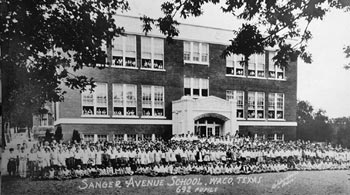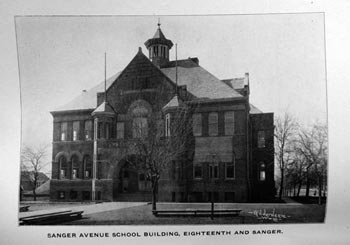
|

|
Waco loses architectural landmark
|
|
Sanger Avenue Elementary School was once the finest public school in Waco, the center of an upscale North Waco neighborhood nicknamed the "Silk Stocking District." The dean of Waco architects, Milton Scott , designed the building with a cupola, a rotunda, an upstairs auditorium and handsome arches. It was built to last. For 104 years it survived generations of wear and tear from children, and more than three decades of disuse. Now the oldest school building in Waco lies in charred ruins, and an irreplaceable link to Waco's past is up in smoke. "It takes away from Waco's history to lose something like this," said Waco architect B.J. Greaves. "This is a tremendous loss to the architectural heritage of our town." The building, at the corner of 18th Street and Sanger Avenue, was the last survivor of three grand elementary schools built from a 1903 bond election. It outlasted the original Bell's Hill and Brook Avenue elementary schools. "This was the last one," Greaves said. "It's unfortunate that we've lost it. I always held out high hopes that somehow the building could be restored." Greaves said the building was a remnant of an age when beauty and solidity were valued in public buildings. "To me it was the detailing," he said. "There was the cupola, the turrets on the front, a large arched entrance and some really nice brickwork with different kinds of coursing and projections. It looked like a very inviting building, and I always thought it would be great fun to go to school there." Glory days rememberedSharon Griffith, who attended the school from 1950 to 1956, said she was heartbroken to hear the news. "It was a beautiful place," said Griffith, who co-owns The Mansion restaurant in McGregor. "I remember the big staircases, the library and the beautiful woodwork. And it had some of the neatest teachers." She recalled the annual May Fete celebration, an operatic performance in the old auditorium, and the colorfully dressed principal Nina Glass, who carried an old bell and loved to join children's softball games. "It was a school everyone wanted to go to," she said. The building was designed by Milton Scott , who was also the architect for the Dr Pepper building, the old Waco High School on Columbus Avenue, the Clifton House, the Roosevelt Hotel, First Baptist Church and many other Waco landmarks. The building saw additions in 1929 and 1931 that covered up much of the architectural detailing Scott had designed. In the early days, the school was surrounded by large Victorian houses owned by bankers, doctors and prosperous merchants. Billy Loden, who grew up attending South Waco Elementary School, remembers playing Sanger in baseball in the mid-1940s. "We called them the Silk Stocking Sissies of Sanger Avenue," he said. "Anyone north of Austin Avenue, we thought were rich." The building outlasted the plush reputation of the neighborhood and many of the grand old houses. |


Closed by desegregationWaco Independent School District shut it down in 1974 as part of a busing plan to meet a federal desegregation order. By then the school's population was about half black, and plaintiffs in the desegregation lawsuit opposed its closure, saying the school was still serviceable. Part of the school continued to be used for Head Start programs, but much of it suffered from neglect in the 1970s. In the mid-1980s, attorneys LaNelle and John McNamara, who lived across the street, bought the property for $80,000. They installed a new slate-like roof, boarded up the broken windows, removed some asbestos and attempted to find a new use for it. In the 1990s, LaNelle McNamara marketed it to the Equal Opportunity Advancement Corporation for use as a charter school, but the deal was never closed. McNamara said the school building was sturdy up to the end. She said she recently had an engineer from Abilene look at the building. "He said this was the best building he'd seen for its age," she said. McNamara said Saturday that she was floored by the loss. "Milton Scott is turning in his grave," she said. Griffith said she believes the building could have been put to good use. "I always told my husband that if we ever won the lottery, we should buy that school and turn it into condominiums or something. It had fallen on really hard times, but I think it could have been saved. I'm devastated by this. I'll feel a great loss every time I go by there." |
|
Return to Places in Time home page |
|